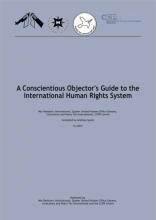Using human rights systems to protect conscientious objectors
We're happy to announce the launch of 'A Conscientious Objector's Guide to the International Human Rights System'. This is an update of 'A Conscientious Objector's Guide to the UN Human Rights System', published in 2000, and covers the multitude of developments that have taken place in terms of human rights and conscientious objection since then.
As well as reading it as a book, you can also use the interactive guide online.
The various human rights systems are complicated and can be off-putting. Different mechanisms have their own processes, requirements, and potential outcomes. In addition, it can be difficult to choose which system might be the most effective, or most promising, to use.
The main purpose of this Guide is to help individuals and organisations who wish to raise issues and cases about conscientious objection to work out what the possibilities are, how to use them, and the likely advantages and disadvantages of the different procedures. We hope that, in breaking down the steps involved, these mechanisms become more approachable.
It will be launched as a side-event to the Human Rights Council in Geneva on 28th May.
This guide was produced jointly with the Quaker United Nations Office, the Centre for Civil and Political Rights, and Conscience and Peace Tax International. It was funded through the Joseph Rowntree Charitable Trust. It is the work, primarily, of Andreas Speck and we are really grateful to him.
We encourage you to take a look at the Guide, and start using it! You'll find it here: http://co-guide.org

Add new comment